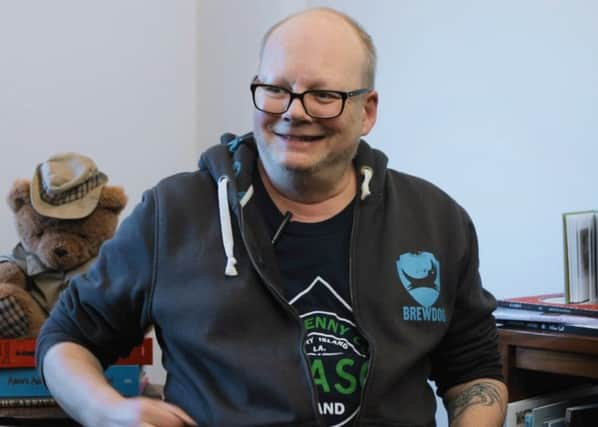Obituary: Stuart McAra, digital effects expert who worked on major films including Harry Potter, Thunderbirds and Star Trek


When he was a young boy in Edinburgh in the 1960s Stuart McAra loved the Thunderbirds and Captain Scarlet puppet shows. He would act out his own little versions of the adventures. He even had a Captain Scarlet outfit, with tunic and cap, made for him by one of his aunts.
As an adult on the other side of the world in New Zealand, McAra got to play with Thunderbirds again, taking command of a digitally animated revival towards the end of a career that had seen him work on ground-breaking digital effects on Harry Potter, Transformers, Star Trek and Avengers films.
Advertisement
Hide AdAdvertisement
Hide AdMcAra made up his mind as a young boy that he wanted a career in film and television, though he had little idea of what he might actually do.


He worked his way up from runner (general dogsbody) to digital effects producer in England and Hollywood with CFC, the Computer Film Company, and in Singapore with ILM, George Lucas’s Industrial Light and Magic company.
Jeremy Hall, who worked with him, at both CFC in California and later at Pukeko in New Zealand, said “CFC were the first company to build a complete digital pipeline. He was there at the beginning of the story with CFC and then went to LA and was at the forefront of digital work in LA.
“Then the first Harry Potter was instrumental in creating the industry in London as it is now.”
In Harry Potter and the Philosopher’s Stone (2001), the first film in the series, the Great Hall of Hogwarts School of Witchcraft and Wizardry was originally lit by dozens of real candles suspended on tungsten wires above the pupils’ heads. All the visual effects team would have to do was digitally remove the wires.
But the candles burned through the wires and fell on to the tables below, endangering the actors, so the filmmakers opted to add the candles to the film digitally instead.
“He worked for all the primary companies and was pretty much at the forefront of it all,” said Hall.
Born in Edinburgh in 1964, Stuart Bannerman McAra was the only child of Robin and Cookie McAra, who were both civil servants. Initially he went to Stewart’s Melville junior school, but he was not academic and transferred to the state sector, finishing his primary education at Flora Stevenson before going on to Broughton.
Advertisement
Hide AdAdvertisement
Hide AdHe got a modest start in film-making when he came across an unused video camera in a school storeroom and made a few silent shorts. He had a brief period selling personal computers and he spent 18 months as a stagehand with Theatre Workshop in Stockbridge.
He enrolled in a practical course in film-making at Bournemouth and Poole College and brought a crew up to make a film at the old Leith Station. The experience persuaded him that he did not want the stress and workload of being a producer or director.
He joined CFC, the Computer Film Company, in London, as a runner, and was soon working on rudimentary digital visual effects, such as removing electricity pylons from the landscape in medieval battle scenes. He was credited as an “additional compositor” on the Oscar-winning film Braveheart (1995). This was the early days of digital work.
McAra was very good at networking and establishing relationships and he persuaded CFC to allow him to go to California to open an office there. Subsequently he did a lot of digital work with Cinesite Europe and was visual or digital effects producer on Mission: Impossible II (2000), Lara Croft: Tomb Raider (2001) and the first Harry Potter films.
He particularly enjoyed his time in Mexico on The Legend of Zorro (2005) and sent tequila-flavoured lollipops to family back home, complete with the famous worm.
He worked for several other companies before moving to Singapore to join ILM. He was visual effects producer there on Transformers: Dark of the Moon (2011), Rango (2011), the superhero movie Avengers Assemble (2012) and Star Trek into Darkness (2013).
After Disney took over ILM, he returned to Scotland, converting an old school building in Speyside into a home, which he called “The Ranch” and where he was a generous and enthusiastic host.
In a dramatic change of pace, he packed cases and drove a forklift truck for the craft beer company BrewDog, before a phone call took him to New Zealand and the chance to work on Thunderbirds.
Advertisement
Hide AdAdvertisement
Hide AdPukeko was an offshoot of Peter Jackson’s Weta special effects company. Jackson, who directed the Lord of the Rings films, was a kindred spirit. He had also been inspired by Thunderbirds as a child and was keen to revive the show.
The original Thunderbirds show in the 1960s had used marionettes on scale-model backgrounds. The revived series Thunderbirds are Go, a co-production between Pukeko and ITV, combined digitally animated characters and scale models.
A balding, bespectacled figure in a BrewDog hoodie, McAra’s delight at being involved in Thunderbirds is more than obvious in a photograph of cast and crew on the set of Tracy Island.
He was diagnosed with prostate cancer at the end of 2015, but continued working. In an episode in the second season of Thunderbirds are Go in 2017 a character was created in McAra’s likeness and he provided the voice.
A brief marriage ended in divorce. He did not have children. He is survived by his parents and his partner Natalie Stevens, who also works in the film industry.
BRIAN PENDREIGH